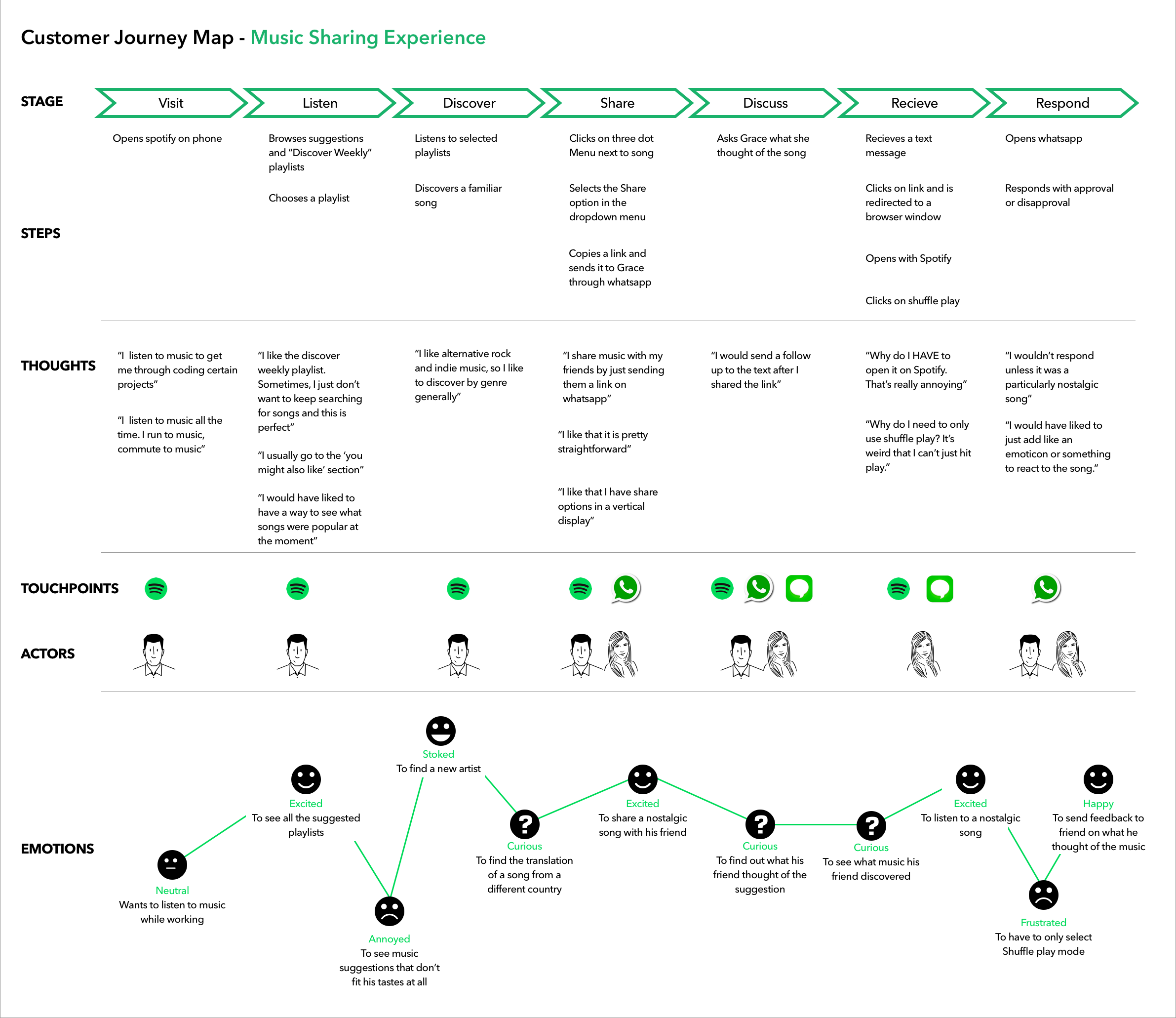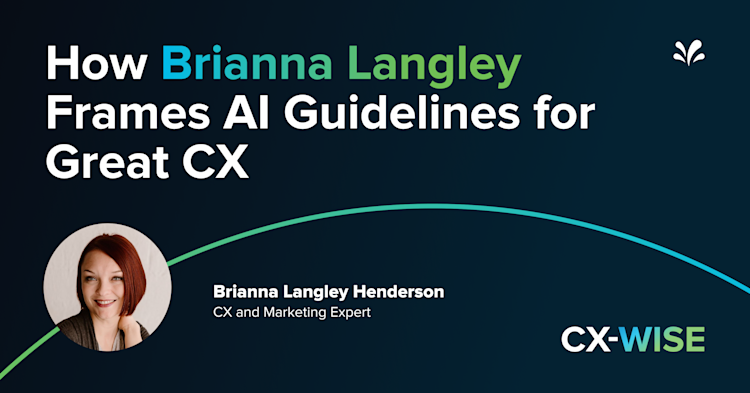What is a customer journey?
The customer journey is the sum of all the interactions a customer has with a brand before, during and after a purchase. A smooth, effortless customer journey can ensure a prospect converts into a customer in the quickest time possible.
Brands need to factor in consumer needs and behavioral patterns when mapping out customer journeys to deliver a great end-to-end customer experience (CX) and achieve their business goals faster.
What is a customer journey map?
A customer journey map helps brands visualize all the interactions a prospect or customer has with the brand, product, or service. These interactions, also called touchpoints, can vary in number depending on your customers’ preferences, their end goals, and the channels through which they interact with your brand. A detailed customer journey map can help you understand your customer pain points and customize individual touchpoints accordingly.
Why is the customer journey important?
Having a firm understanding of how customers engage with your brand lets you accomplish the following:
Having a firm understanding of how customers engage with your brand lets you accomplish the following:
#1. Better customer experience
Today’s customers have more options than ever and have much higher expectations regarding product, price and service than ever before. To meet and exceed those expectations, brands must identify their customers’ likes and preferences.
With a clear view of the customer journey and the various phases a customer navigates to address their objective, brands can deliver superior experiences to their customers.
#2. Faster conversion
Customers switch between different customer touchpoints quite often during their journey. For example, an angry customer may first try to reach a service agent on the phone and then move to a messaging channel like Messenger in the hopes of a faster resolution.
If this transition isn’t smooth, your customers may not feel invested enough to continue their journey to achieve their goals, whatever they may be. A customer journey that is free from obstacles, such as an inconsistent experience when switching between touchpoints, impacts your conversion rate.
#3. Customer delight
A customer’s journey doesn’t come to an end immediately after they’ve made a purchase. A happy and satisfied customer often comes back for more. In fact, they become loyal brand advocates, increasing brand affinity.
Audience analysis and designing persona-driven journeys will help create more positive “moments of truth” — a significant brand-customer interaction whereby the customer forms or changes their impression of your brand — ultimately leading to customer delight.
Customer journey vs. Customer experience
Customer journey and customer experience might sound similar, but they represent distinct aspects of the customer's interaction with a brand.
Aspect | Customer journey | Customer experience |
Definition | The specific path or series of touchpoints that a customer goes through when interacting with a business | The overall sum of all interactions, impressions, and feelings a customer has during their journey |
Focus | Sequential steps and touchpoints in the customer's interaction with a company | Holistic view of the entire customer-brand relationship |
Timeframe | Typically viewed as a structured sequence of interactions over time | Encompasses all interactions, whether they are part of a journey or not, and may not be limited to a specific timeframe |
Scope | Emphasizes individual touchpoints, actions and channels within the customer's path | Encompasses all touchpoints, whether planned or unplanned, and includes pre-purchase and post-purchase experiences |
Key Elements | Phases and touchpoints | Emotions, perceptions, satisfaction and overall impression. |
Metrics | Customer journey metrics assess each stage and touchpoint in customer interactions. Eg: conversion rate, call abandonment rate, first-contact resolution, Average handle time (AHT) and Customer effort score (CES) | Customer experience metrics gauge overall customer satisfaction and perception across interactions. Eg: Customer satisfaction (CSAT), Net promoter score (NPS), Customer lifetime value (CLV) and average customer retention rate. |
Read More: Top 7 Customer Experience Metrics to Track
Five stages of customer journey [Key phases]
The customer journey phases represent the different stages your prospects and customers go through as they interact with your brand. These phases usually include multiple touchpoints and are classified as follows.
💡Awareness
This is when a prospect is looking for a solution to their business problem(s) through research on search engines and, in the process, comes across your brand and product.
Customers become aware of your brand and products.
Initial interaction via social media, search engines or recommendations.
Roadmap for brands: Focus on providing informational content that answers questions and builds trust.
Example: In this initial stage, the call center leader becomes aware of a problem - growing agent attrition. To find solutions, they turn to Quora, a popular platform for information and discussion. Here, they search for "Why are agents leaving my call center?" and stumble upon a highly informative response from a Sprinklr representative. This response lists the top reasons for agent attrition, instantly grabbing the leader's attention. The trust is established as the information is accurate and relevant, positioning Sprinklr as a knowledgeable source.
🤔Consideration
The prospect then tries to identify the most appropriate solution for their specific business needs by visiting your website and your competitors to evaluate their options.
Customers consider your brand as a solution.
They compare products and alternatives.
Roadmap for brands: Provide content highlighting problem-solving features without aggressive sales tactics.
Example: At this point, the call center leader is intrigued and motivated to explore Sprinklr's solutions further. They visit Sprinklr's website, where they find a wealth of valuable content related to call management, employee engagement and call center guide to agent retention.
Impressed by the depth and relevance of the content, the leader signs up for Sprinklr's blog, showing interest in staying updated with industry insights. This indicates a growing consideration for Sprinklr as a potential solution provider to address their attrition issue.
💰Purchase
The prospect shortlists potential solutions that they think will solve their needs and then proceeds to shortlist your product or service along with a few others. Then, after a period of deliberation, decide to buy or adopt your offering.
Customers develop preferences for reading through the available content on the internet
They decide to take a demo or a free trial
Based on their experience, customers decide to make a buying choice
Roadmap for brands: Persuade customers with pricing, comparison guides and abandoned cart emails.
Example: As the leader continues to engage with Sprinklr's content and resources, they begin to develop a preference for the company's offerings. They reach out to Sprinklr's sales team or request a demo of the Unified-CXM platform.
After a successful demo and discussions with Sprinklr's sales representatives, they decide to make a purchase. This stage involves the leader becoming a paying customer, signaling their commitment to solving the agent attrition challenge with Sprinklr's assistance.
🙌Retention
After a while, the customer may have issues with your product or service and decide to reach your customer support for help. Or they may wish to renew or upgrade their existing product or service, and subsequently land on your FAQ pages to understand their options.
Roadmap for brands: Focus on keeping existing customers and driving repeat business. Maintain positive relationships with email outreach, coupons and exclusive communities.
Example: The call center leader and their team receive onboarding assistance, training and ongoing support from Sprinklr's team to ensure a smooth implementation. In this stage, the call center leader's success and satisfaction with Sprinklr's solutions are crucial to building a long-term customer relationship, potentially leading to future collaborations and referrals.
After implementing Sprinklr's Unified-CXM platform to address agent attrition, the call center leader began to witness significant improvements in employee retention. The attrition rate decreases and job satisfaction among the call center agents increases due to better working conditions, streamlined processes and improved support systems offered by Sprinklr's solution.
The call center leader decides to continue using Sprinklr’s Unified-CXM platform and reap its benefits in the form of better productivity and great customer experiences.
Read more: The Call Center Guide to Agent Retention
📢Advocacy
The final stage involves the customer being so happy with their experience with your brand that they recommend your solution to others. They do this through word of mouth – text, calls and by leaving positive reviews on the platform of their choice. Delighted customers actively encourage others to make purchases.
Roadmap for brands: Offer referral bonuses, loyalty programs and special deals to promote advocacy further.
Example: In the Advocacy stage, the call center leader becomes a vocal advocate for Sprinklr. Their success story becomes a powerful testimonial for Sprinklr's solution. The leader is now not only retaining their team but also sharing their positive experiences with colleagues in the industry, both online and in professional networking events.
The call center leader might write a blog post or participate in industry webinars, sharing how Sprinklr's Unified-CXM platform helped them combat agent attrition effectively. They recommend Sprinklr to peers and industry forums where similar challenges are discussed. The leader's advocacy not only enhances Sprinklr's reputation but also leads to potential referrals and new business opportunities for the company.
Dig Deeper: How to Turn Customers into Brand Advocates
What is a customer journey map?
A customer journey map is a visual representation of the entire experience a customer has with a business, from initial awareness to post-purchase interactions.
It helps businesses understand and improve the customer's path, enabling them to identify pain points and opportunities for engagement to enhance customer satisfaction and loyalty ultimately.
These interactions, also called customer touchpoints, can vary in number depending on your customers' preferences, their end goals and the customer service channels through which they interact with your brand. Regardless, customer journey mapping is the foundation of customer lifecycle management.
How to create a customer journey map
To create an efficient customer journey map, understand these four key elements.
Customer journey stages: Your map should cover every stage of the customer journey, from initial awareness to post-purchase advocacy. Don't limit your focus to just the buying stages; consider the entire customer lifecycle.
Touchpoints: Identify and document the most common touchpoints that customers encounter at each stage of their journey. These touchpoints could include your blog, social media, reviews or email. Prioritize the most relevant touchpoints to ensure a comprehensive view.
The full customer experience: Recognize that customers' actions, motivations, questions and pain points change as they progress through the journey and interact with different touchpoints. Your map should encompass the entire customer experience at each touchpoint.
Your brand's solutions: Provide solutions tailored to each stage and touchpoint. These solutions may not always involve a direct purchase; for instance, an awareness-stage solution could be a blog, video or social media post aimed at furthering the reader’s understanding of the topic.
With these essential elements in mind, creating an effective customer journey map becomes a straightforward three-step process.
1st Step: Create buyer personas
Before mapping the customer journey, it's crucial to understand your audience. To do this, create buyer personas - fictional representations of your target customers. These personas should encompass their background, motivations, pain points and needs.
Here's how you can create a buyer persona:
Gather and analyze customer data: Collect information through analytics, surveys, and market research to understand your customers better.
Segment customers: Categorize customers into groups with shared characteristics, such as demographics or location.
Build personas: Select a segment to target and create a persona for that group. Include basic traits, motivations and pain points.
For example, Steve, “a marketing manager” might be a persona for marketing platforms like Marketo with detailed information about his pain points and preferences.
2nd Step: List touchpoints at each customer journey stage
Now that you have your buyer personas, it's time to identify touchpoints at each stage of the customer journey. This step involves listing the marketing channels where customers can interact with your brand. Key touchpoints at each stage typically include:
Awareness: Advertising, social media, blogs, referrals, and more
Consideration: Email, sales calls, landing pages and reviews
Purchase: Live chat, cart abandonment emails and more
Retention: Thank-you emails, product walkthroughs and online communities
Advocacy: Surveys, loyalty programs and events
By thoroughly identifying these touchpoints, you can ensure you engage with your customers effectively and consistently throughout their journey.
3rd Step: Map the customer experience at each touchpoint
Now, it's time to detail the experience you want to create for customers at each touchpoint. For each touchpoint, consider the customer's:
Actions: Describe how the customer arrives at the touchpoint and what they are likely to do there.
Motivations: Understand the customer's emotional state at that moment. Are they curious, frustrated, or excited? Explore why they feel this way.
Questions: Anticipate customers' questions at each stage and how your brand can provide answers.
Pain points: Identify the problems customers encounter and how your brand can address these issues.
Make sure your brand's solutions cater to each of these stages in the customer's journey, from the time the customer becomes aware of your solution to the consideration stage to the decision stage and finally towards the delight stage.
By mapping out these details, you can respond effectively to your customer's needs at every step of their journey. The goal is to deliver the exact experience they expect from your business, ultimately increasing engagement and sales.
Examples of successful customer journey implementation by brands
Spotify
The global audio streaming giant decided to enhance the music-sharing experience for its users. They partnered with a marketing firm to craft a customer journey map to achieve this.
The objective was crystal clear: pinpoint where music-sharing features could seamlessly integrate into the user experience.

Spotify's map meticulously traces the user's voyage from opening the Spotify app on a mobile device to their engagement with shared songs. At each stage and touchpoint, it delves into what users engage with, do, think, and feel. This thorough analysis leveraged data research and customer surveys to grasp user sentiments at various points in the customer journey.
Using this valuable map, Spotify identified pain points and tailored solutions to create a smoother, more enjoyable music-sharing experience.
The result? Elevated customer satisfaction, leading to a seamless buying journey, stronger customer loyalty and often, customers evolving into enthusiastic brand advocates.
boAt
boAt, one of the top wearable electronics brands, started with audio devices and gadgets and then charted a course toward smart wearables. Their focus? Placing customers at the heart of their journey, delivering luxury audio and entertainment technology at attractive prices. They embarked on a digital transformation to navigate this mission, seeking a data-driven foundation to steer their growth.
Challenge: To truly understand customers' desires, boAt needed to be in tune with the market's pulse. They aspired to decipher consumer conversations, identify desired product features and maintain affordability.
A data analytics practice was established from the ground up to become an intelligent enterprise guided by data-driven insights, with Sprinklr as a key platform.
Solution: By harnessing Sprinklr's Unified-CXM platform, boAt is weaving together multiple solutions, culminating in a seamless experience for both customers and employees. Since the launch, they've welcomed 140 team members to the Sprinklr platform, delving into over 10,000 customer touchpoints and swiftly validating 6,000 warranty claims in real-time. This newfound visibility into customer interactions perfectly aligns with boAt's digital transformation journey.
From quality and speed metrics to a unified platform for workflow transparency, boAt ensured that its customers received uninterrupted cross-channel support. They leveraged AI technology to speed up claims and warranty processes and transitioned from reactive to proactive, predictive and preventive measures.
Interesting Read: The Very “Undigital” Truth About Digital Transformation
Outcome: boAt transformed its operations by integrating numerous solutions into Sprinklr's Unified-CXM platform. Since its implementation, boAt has seamlessly onboarded 140 employees to the Sprinklr platform, meticulously analyzed over 10,000 customer touchpoints and swiftly validated more than 6,000 warranty claims in real-time.
This enhanced visibility into customer interactions is precisely what boAt sought when commencing its digital transformation journey.
If you want to map better customer experiences, just like boAt did, take a tour of Sprinklr Service.
Frequently Asked Questions
Thank you for contacting us.
A Sprinklr representative will be in touch with you shortly.
Contact us today, and we'll create a customized proposal that addresses your unique business needs.
Request a Demo
Welcome Back,
No need to fill out any forms — you're all set.



